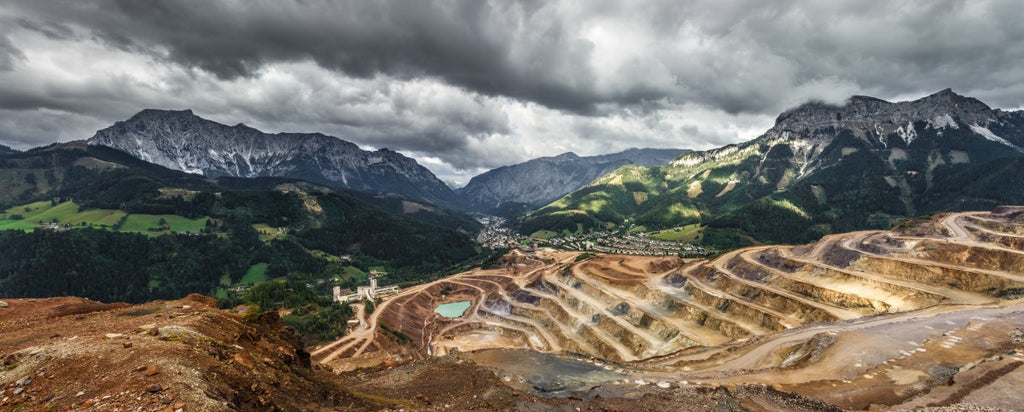Your Cart is Empty

For over a century, cyanide, mercury and other toxic substances have been employed in the gold-mining process. The regular release of these harsh chemicals has, over time, ravaged landscapes, contaminated water supplies, and contributed to the destruction of vital ecosystems.

Practises of modern industrial gold mining like pit mining and cyanide heap leaching generate roughly 20 tons of toxic waste for every gold wedding ring. The waste - usually a grey sludge - is loaded with deadly cyanide and toxic heavy metals.
Many gold mines dump their toxic waste directly into natural bodies of water. It's estimated that mining companies across the globe are responsible for disposing of at least 180 million tons of toxic waste into rivers, lakes and oceans every year, destroying coral, marine life and freshwater ecosystems in the process.
When dams are created to store toxic waste (an attempt to limit environmental damage) chemicals instead contaminate the surrounding environment by seeping into the soil, or worse - surging in catastrophic spills. Of approximately 3,500 dams worldwide, one or two major spills occur every year, poisoning water supplies and killing fish.
In 2009, gallons of process solution containing sodium cyanide overflowed from the Ahafo open pit mine in Ghana. The Asanua river was contaminated, depriving communities of access to clean water, thousands of fish killed, and access to crops inhibited; a fatal outcome for a community that has long relied on farming. A Ghanaian Ministerial Panel evaluated the spill and its aftermath at roughly $4.9 million in damages.

Acid main drainage is a form of water pollution when rain or streams come into contact with rock rich in sulfur. As a result, the water becomes highly acidic and damages downstream aquatic ecosystems. In some regions - like in the USA's Mid-Atlantic region, it's the most common form of freshwater pollution.

Mercury, a liquid metal, is used by miners to extract gold from rock. The mining sector is responsible for the largest releases of mercury to the environment of any sector globally. A major source of air pollution, gold mining releases approximately 400 metric tons of airborne elemental mercury each year - that's roughly 2 grams of mercury for every gold wedding ring.
When mercury enters the atmosphere or reaches rivers, lakes, and oceans, it can travel great distances.
Mercury is unfortunately a toxic substance, and its use in gold-mining has been labelled a "huge public health threat" by health experts. The vapour released by mining activities has been proven to damage the kidneys, liver, brain, heart, lungs, colon, and immune system. Chronic exposure to mercury may result in fatigue, weight loss, tremors, and shifts in behaviour. In children and developing fetuses, mercury can impair neurological development.

The Gold Rules are Earthworks' criteria for responsible mining, production and trading of gold. They developed the Golden Rules as part of their No Dirty Gold campaign, based on broadly accepted international human rights laws and basic principles of sustainable development.
By committing to these rules, we have pledged to pursue and encourage 'cleaner' sourcing of gold.
The Golden Rules state that mining companies and operations must:
1. Respect basic human rights outlined in international conventions and law
2. Obtain the free, prior and informed consent of affected communities
3. Respect workers' rights and labour standards, including safe working conditions
4. Ensure that operations are not located in areas of armed or militarised conflict
5. Ensure that projects do not force communities off their land
6. Ensure that projects are not located in protected areas, fragile ecosystems, or other areas of high conservation or ecological value
7. Refrain from dumping mine wastes into the ocean, rivers, lakes or streams
8. Ensure that projects do not contaminate water, soil or air with sulfuric acid drainage or other toxic chemicals
9. Cover all costs of closing down and cleaning up mine sits
10. Fully disclose information about social and environmental affects of projects
11. Allow independent verification of the above

Choosing traceable artisanal gold is an opportunity to transform the mining industry into an active force for good. Often, artisanal gold - particularly that which is third party certified - is priced with a small premium. Largely, these premiums are invested in educational, healthcare or environmental projects, making a huge long-term difference to the lives of the miners and their communities. The traceability of artisanal gold enables us to ensure that safe working conditions, fair wages, just trading opportunities and environmental conservation are prioritised.